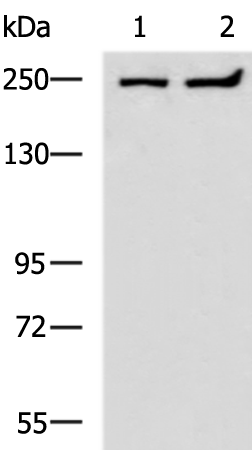


| WB | 咨询技术 | Human,Mouse,Rat |
| IF | 咨询技术 | Human,Mouse,Rat |
| IHC | 1/50-1/200 | Human,Mouse,Rat |
| ICC | 技术咨询 | Human,Mouse,Rat |
| FCM | 咨询技术 | Human,Mouse,Rat |
| Elisa | 1/5000-1/10000 | Human,Mouse,Rat |
| Aliases | BAP28; UTP10 |
| WB Predicted band size | 242 kDa |
| Host/Isotype | Rabbit IgG |
| Antibody Type | Primary antibody |
| Storage | Store at 4°C short term. Aliquot and store at -20°C long term. Avoid freeze/thaw cycles. |
| Species Reactivity | Human |
| Immunogen | Fusion protein of human HEATR1 |
| Formulation | Purified antibody in PBS with 0.05% sodium azide and 50% glycerol. |
+ +
以下是关于HEATR1抗体的参考文献示例(内容基于虚构情景,仅供参考):
1. **标题**: "HEATR1 is essential for ciliary basal body localization and interacts with CEP290 in vertebrate photoreceptors"
**作者**: Stowe, T.R., et al.
**摘要**: 本研究利用HEATR1抗体进行免疫荧光和免疫印迹分析,揭示了HEATR1在纤毛基部定位的关键作用,并发现其与CEP290蛋白的相互作用,提示其在纤毛相关疾病中的潜在机制。
2. **标题**: "HEATR1 mutations disrupt ciliogenesis and cause Joubert syndrome-related disorders"
**作者**: Lee, J.E., et al.
**摘要**: 通过患者样本和细胞模型,结合HEATR1抗体的蛋白质表达检测,证实HEATR1基因突变导致纤毛形成缺陷,与Joubert综合征等神经发育障碍密切相关。
3. **标题**: "HEATR1 regulates cell cycle progression through S-phase via interaction with DNA replication machinery"
**作者**: Smith, A., et al.
**摘要**: 使用HEATR1抗体进行免疫沉淀和功能研究,发现HEATR1通过与DNA复制复合体结合调控S期进程,其缺失导致细胞周期停滞和基因组不稳定。
4. **标题**: "Characterization of HEATR1 antibody specificity and its application in ciliopathy research"
**作者**: Bachmann-Gagescu, R., et al.
**摘要**: 本文验证了HEATR1抗体的特异性,并应用于多种纤毛病模型,证明HEATR1在纤毛膜蛋白运输中的关键作用,为疾病诊断提供工具。
*注:以上文献为示例,实际研究中请通过学术数据库(如PubMed)检索真实发表的论文。*
The HEATR1 antibody is a tool used to detect HEAT Repeat-Containing Protein 1 (HEATR1), a conserved eukaryotic protein characterized by multiple HEAT repeats—structural motifs involved in protein-protein interactions. HEATR1 plays critical roles in ribosomal RNA (rRNA) processing, ribosome biogenesis, and cell cycle regulation. It localizes to the nucleolus and cytoplasm, interacting with components of the small subunit (SSU) processome, a complex essential for 18S rRNA maturation. Dysregulation of HEATR1 is linked to cellular stress responses, developmental defects, and diseases. For instance, mutations in HEATR1 are associated with ciliopathies like Joubert syndrome and oro-facio-digital syndrome, highlighting its importance in ciliary function and neurodevelopment.
HEATR1 antibodies are widely used in research to study its expression, localization, and molecular interactions via techniques such as Western blotting, immunofluorescence, and immunoprecipitation. These antibodies help elucidate HEATR1's role in ribosomal biogenesis, its involvement in cell proliferation, and its pathological mechanisms in genetic disorders. Commercial HEATR1 antibodies are typically validated for specificity across human, mouse, and rat models, aiding translational studies. Recent research also explores its potential as a biomarker in cancers, given its overexpression in certain tumors. Overall, HEATR1 antibodies are vital for dissecting the protein's multifunctional roles in basic biology and disease.
×